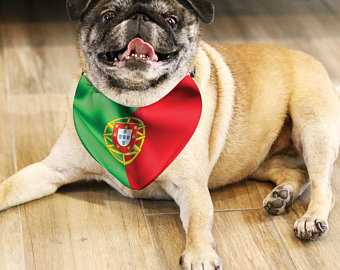1. Barbado da Terceira
The Barbado da Terceira is Portuguese breed of herding and guards dog from the Atlantic island of Terceira in the Azores, for which it is named. It was recognised by the Direcção-Geral de Veterinária of Portugal in 2004. It is not recognised by the Fédération Cynologique Internationale.
The Barbado da Terceira derives from the various dogs brought to the Azores by colonists and visitors since the settlement of the islands began in the fifteenth century, particularly from those with an aptitude for cattle herding. It was used both as a herding dog and as a guard dog.
It was recognised by the Direcção-Geral de Veterinária of Portugal in 2004, based on the results of a collaboration between the Clube Português de Canicultura, the Direcção Regional de Agricultura of Terceira and the University of the Azores. A census in 2005 found 222 of the dogs.
It is not recognised by the Fédération Cynologique Internationale.
2. Cão de Gado Transmontano
The Cão de Gado Transmontano (Portuguese pronunciation: [ˈkɐ̃w̃ dɨ ˈɣaðu tɾɐ̃ʒmõˈtɐnu])is a giant dog breed of molosser type, and primarily a working dog used as a livestock guardian. Originating in the region of Trás-os-Montes e Alto Douro Province, Portugal, it is a rare breed mostly confined to this area.[ Their primary function is flock and herd protection, and their success is interlinked with the welfare of the flock and the presence of wolves, particularly. Although they are a regional breed, their wolf-defence capacity has led to limited experimental importation elsewhere. The FCI officially refers to them as Transmontano Mastiffs and some Portuguese breed clubs that provide translated webpages in English have also referred to them as Transmontano cattle dogs.
3. Castro Laboreiro Dog
The Castro Laboreiro Dog (Portuguese: cão de Castro Laboreiro, ‘dog of Castro Laboreiro’), also known as the Portuguese cattle dog or Portuguese watchdog, is an “extremely ancient” dog breed of the livestock guardian type, originating from Castro Laboreiro in the northern mountains of Portugal.
The standardised appearance for which the Castro Laboreiro Dog has been bred is somewhat wolf-like in outline. It is a large dog, but not oversize. Height should not be above 60 cm (24 in) at the withers and weight should not be more than 40 kg (88 lbs); females somewhat smaller. Coat colours are often described in wolf terms: “dark wolf colour”, “light wolf colour”. Most breeders prefer what is considered the most authentic, called “mountain colour” also described as similar to the coat of a wolf, but a mixed light and dark grey interspersed with individual hairs (not spots) that are brown (called “pine-seed”) or dark red (called “mahogany”), forming overall a brindle pattern.
4. Estrela Mountain Dog
The Estrela Mountain Dog (Portuguese: cão de Serra da Estrệla) is a large breed of dog from the Estrela Mountains of Portugal bred to guard herds and homesteads. It is “one of the oldest breeds in the Iberian Peninsula.
The breed has been developed in the mountains of Serra da Estrela, in what is now Portugal. The Estrela Mountain Dog is one of the oldest breeds in Portugal. The earliest of the Estrela ancestors were herd-guarding dogs in the Serra da Estrela, in what is now Portugal. There is no written record of their history.
Life changed little for the people and dogs of the region, even into the 20th century. The isolation of the region meant the breed was relatively unknown outside it until the early 1900s, and even then, they were mostly ignored in early dog shows. The Portuguese admired foreign breeds much more than their own. Shepherds often castrated their dogs to prevent them from leaving their flocks to mate. These factors had a negative effect on Estrela. So from 1908 to 1919, special shows called concursos were held to promote and preserve the Estrela breed in the region. During this period there was some attempt at a registry (of which there is no surviving record). Special livestock guardian working trials were included in these shows. The trial consisted of an owner/shepherd bringing his dog into a large field with many flocks of sheep. The dog was observed by judges for its reactions coming into the field and as the shepherd was ordered to move the flock, which inevitably produced stragglers. The dog was expected to move from his spot of guarding to bring the stragglers back, and then assume a leadership position at the head of the flock.
The first, tentative, recorded breed standard was published in 1922. This standard only reflected the functional features naturally found in the best dogs of the time, although it did mention having dewclaws as reflecting a “perfect” dog. The characteristic hooked tail and turned-back (rosed) ears, which later became part of the official standard, were not mentioned in this preliminary standard.
The first official breed standard was written in 1933. This standard attempted to differentiate the Estrela as a distinct breed. This led to the hooked tail and double dewclaws becoming a requirement. All colours were allowed. The standard has undergone small refinements since then. For example, dewclaws became optional by 1955, and the allowed colours have been limited a few times to achieve today’s current set. Read More…
5. Estrela Mountain Dog portrait
Prior to World War II, the Estrela breeders were still primarily the shepherds and farmers of the region. Since they were mostly illiterate, they did not make any attempt to follow the official breed standard, if they even knew one existed. But by the early 1950s, interest in the breed returned, and the annual Concurso was reinstated. Again the intent was to stimulate interest among the Serra residents and to encourage them to adhere to the official standard. During this period, the long-haired variety was most popular at shows, but “show dogs” represented (and still do) only a small portion of the Estrela population in Portugal. Many of the working dogs were (and are) short-haired.
6. Estrela Mountain Dog resting
Early in the 1970s, interest was steeply declining. There was some concern about the degeneration and even possible extinction of the breed. But the Portuguese revolution of 1974 helped save the Estrela. It led to changes both in dog shows in Portugal and in Portuguese dog breeds. Prior to the revolution, dog show had largely been a pastime of the wealthy, with their preference for non-Portuguese breeds as status symbols. Now, working people could and did show the native dogs they preferred. Also, the revolution came an increase in crime and thus more interest in guard dogs.
There is no record of the Estrela outside Portugal prior to 1972. While some undoubtedly did leave the country, they were probably interbred, with no effort to maintain the breed. In 1972 and 1973, pairs were imported to the US. Others were probably imported into the US since then, but it was not until 1998 that the first papered dog was imported into the United States. The United Kingdom was the first country to establish the breed outside Portugal in 1972. Today the Estrela can be found in many countries.
Today, the Estrela Mountain Dog remains true to its guardian heritage. It is still a working dog, guarding flocks in its native Portugal and elsewhere (the Portuguese Marines had even used them as patrol dogs). It is also an ideal family pet because of its alertness, loyalty, intelligence, and its instinct to nurture young; all features it needed in its earliest days.
7. Portuguese Podengo
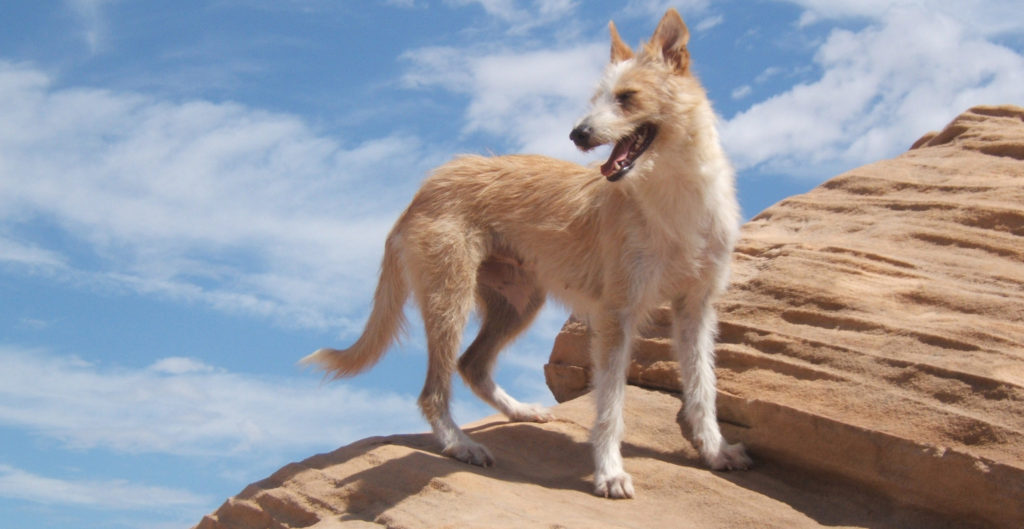
The Portuguese Podengo is hound (sight and scent) breed from Portugal. As a breed, the Podengo is divided into three size categories that are not interbred: small (Pequeno), medium (Médio) and large (Grande). Their coats are either short and ‘smooth’, or longer and ‘wired’. The smooth-coated variety is traditional, whereas the wire coated variety is an outcome of the assimilation of various other breeds during the 20th century. In general, the breed is healthy; the Pequeno (small) variety has an average lifespan of approximately 15–17 years.
All Podengo types are hardy, intelligent and lively dogs, excelling at agility and making fine companions. Loyal and fearless, Podengos are also good house guards and are amenable to training by dog experienced people and those that enjoy primitive (unrefined, “less domesticated”) dog behaviour.
Keen hunting dogs, the Podengo has an affinity for the game regardless of size. Typically, the dogs hunt in a pack with their handler following. When the game is found, they kill and retrieve it, or flush it towards the hunter to be shot. Each size category traditionally hunts game appropriate to their size and temperament. (Pequeno: rabbits; Medio: rabbits and wild boar; Grande: deer and wild boar).
The Portuguese Podengo Medio, both smooth and wire-haired, has existed, unregistered, in the United States for decades in small numbers with Portuguese-Americans in private home settings, where they have been used for traditional rabbit hunting. They were never really popularized outside of their immigrant homesteads. They are attractive, nice family dogs, with a touch of mischief. The first group of Podengo Medio fanciers met in the US in the early 1990s via the early internet Gopher (protocol) system. Registered purebred Smooth Podengo Medios began being shown in America in 2004 and registered purebred Wirehaired Podengo Medios began being shown in America in 2005.
The first Wirehaired Podengo Medio to be shown in North America was AM/CDN Ch Evita V.D. Kleiheuvel, owned by Mary Dixon at a United Kennel Club show in Belleville, Michigan. Evita became the first WPM United States Champion (with United Kennel Club) and the first Canadian Podengo Champion (with Canine Federation of Canada). The first Podengo Medio born in North America was Ch Marcos de Retrouvaille and was bred by Dixon. The first Podengo to earn an American Kennel Club Tracking Dog title (on February 17, 2008) was Jolena De Retrouvaille WM, bred by Mary Dixon.
Still rare, breeders in Portugal primarily breed for rabbit hunting, not pets. They are hunting dogs, often kept in kennels, not in homes. The idea of Wirehaired Podengo Medios being kept more as house pets began with breeders in Europe. Read More…
8. Portuguese Pointer
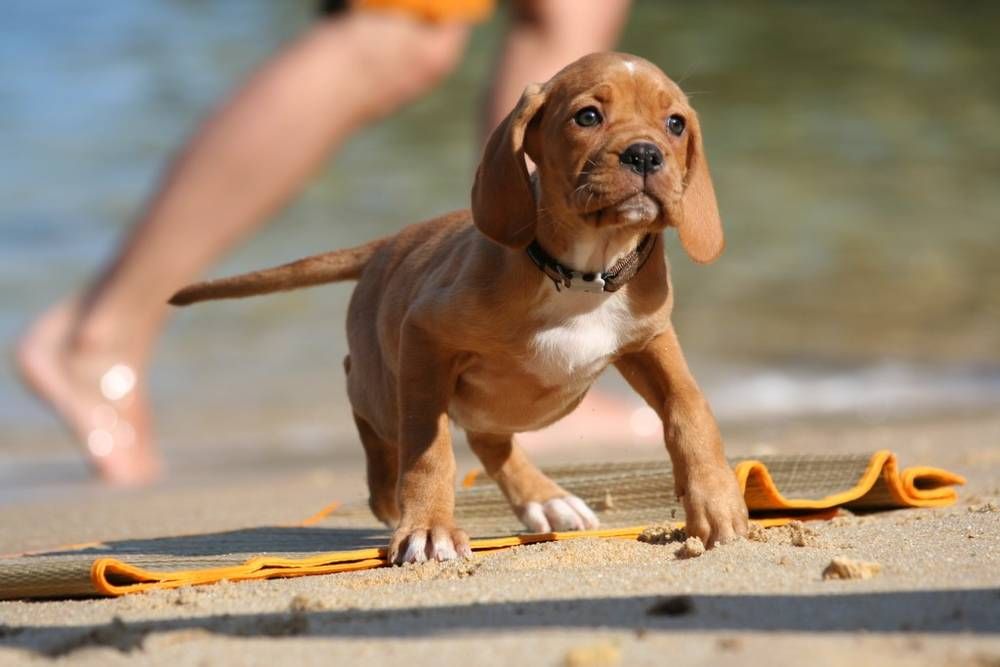
A Portuguese Pointer, (Portuguese: Perdigueiro Português) is a breed of dog developed as a gun dog. It is one of several pointing breeds and is mainly used in red-legged partridge hunting.
The Portuguese Pointer (perdigueiro Português) arose from Iberian hunting dogs with its presence in Portugal traceable to the early twelfth century. Initially, the dog was bred in royal kennels and later became a very popular hunting dog for the lower classes of society. In the eighteenth century, many English families established a presence in the region of Oporto in the business of wine production and came to know the Portuguese hunting breed which was taken to England where they played a part in the origin of the English pointer. However, during the nineteenth century when Portugal was experiencing considerable social hardships, the breed began a progressive decline. It was not until the 1920s when some breeders made an effort to salvage the breed by locating some of the ancient Portuguese dogs in the inaccessible north of Portugal. The Portuguese pedigree book was then established in 1932 and breed standard in 1938. For at least a thousand years, this dog has always had the same square head, a marked stop, triangular ears and compact look and since the 17th century, the same docked tail, and among pointing dogs all over the world just the perdigueiro and his “son” the English pointer have this kind of skull-facial convergence so typical.
Portuguese Pointers are an energetic and affectionate breed. As a hunting dog, the breed is enthusiastic and dedicated. They work in close contact with their handlers and are known to be devoted companions, sometimes to the point of being “inappropriate and inconvenient” in their affections. While very sociable and dedicated to their owner, they can be aloof towards other dogs. Read More…
9. Portuguese Sheepdog
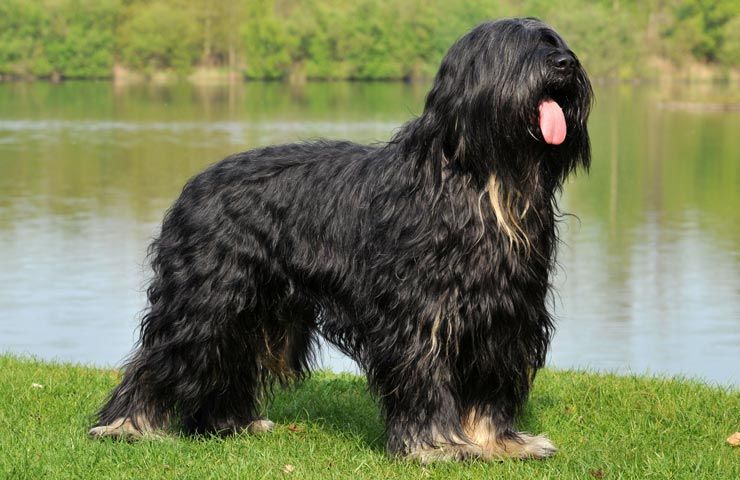
The Portuguese Sheepdog (Portuguese: cão da Serra de Aires, literally ‘dog of Serra de Aires’) is a medium-sized breed of dog of the herding dog type and is one of the indigenous regional dogs of Portugal. The Portuguese name refers to Serra de Aires, a mountain near Montforte in the Alentejo region (sometimes mistaken for the Serra d’Aire, a range of hills or mountains marking the boundary between Ribatejo and Oeste, north of the Tagus river). The breed is nicknamed cão macaco (‘macaque dog’, ‘monkey dog’) for its furry face and lively attitude.
Portuguese Sheepdog is a medium-sized dog, standing 45 to 55 cm (17½ to 21½ ins) at the withers for males (females slightly smaller) and 17 to 27 kg (37 to 60 lbs) in weight. The dog’s body is long and has a long coat without an undercoat, of medium thickness and described as having a “goat-like” texture. The lack of an undercoat makes the dog less resistant to extreme weather as a working dog. Typical coat colours include yellow, chestnut, grey, fawn, wolf grey (fulva e a lobeira), and black, with tan marks. White hairs may be mixed in with the coat, but there should be no large white patches.
The tail should belong, and a natural bobtail is a disqualification under the breed standard, meaning that owners are discouraged from breeding such non-typical dogs, and tailless dogs cannot compete for breed championships. The tail should never be docked. The drop (hanging) ears are set high and close to the head. Detailed descriptions of all of the ideal proportions and colours are listed in the original breed standard, as well as faults which are aspects not typical for the breed or that are structural problems.
Ancestors of the modern breed were traditionally used for herding cows, sheep, goats, horses, and even pigs in the Serra de Aires and in the Alentejo. As with other breeds who came from undocumented, working dog origins, “… data is rare or does not exist … most guardian and herding breeds do not have records before 1900”. The dog is recognisable as one of the old-fashioned types of European sheepdogs, believed to be closely related to the Pyrenean and Catalan Sheepdogs. It is also believed to be descended from Briards imported into Portugal in the early 1900s by the Conde de Castro Guimarães from Cascais and crossed with the Pyrenean Sheepdog. The landscape of the Serra de Aires is barren and harsh and it has been noted that the breed would have had a difficult time adapting to the climate there.
The first breed standard was written by Antonio Cabral and Felipe Morgado Romeiros and was accepted by the Portuguese Kennel Club. The breed was recognised internationally in 1996 by the Fédération Cynologique Internationale, under the name Portuguese Sheepdog in English. The breed has been exported to other countries and has become a popular companion and pet in Europe. In the United States, the breed is recognised by the United Kennel Club in its Herding group as of 2006, also under the name Portuguese Sheepdog. It is also recognised and listed under its original name or various translations by minor kennel clubs, speciality clubs, and Internet dog registry businesses, and is promoted as a rare breed for those seeking an unusual pet. Read More…
10. Portuguese Water Dog
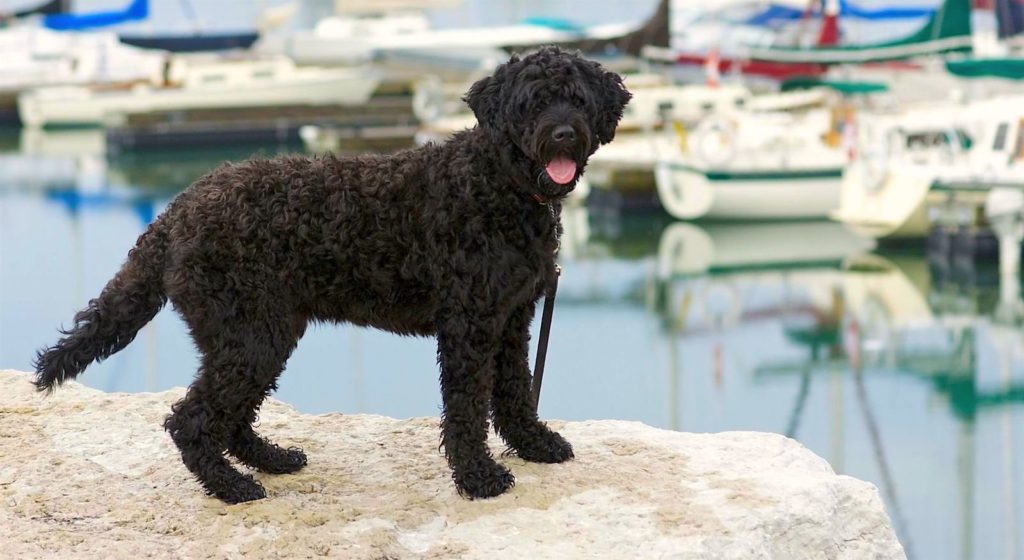
The Portuguese Water Dog is a breed of dog. It is classified as a working dog by the American Kennel Club. Portuguese Water Dogs are originally from the Portuguese region of the Algarve, from where the breed expanded to all around Portugal’s coast, where they were taught to herd fish into fishermen’s nets, retrieve lost tackle or broken nets, and act as couriers from ship to ship, or ship to shore. Portuguese Water Dogs rode in fishing trawlers as they worked their way from the Atlantic waters of Portugal to the waters off the coast of Iceland fishing for cod.
In Portuguese, the breed is called cão de água (IPA: [ˈkɐ̃w dɨ ˈaɡwɐ]; literally ‘dog of water’). In Portugal, the dog is also known as the Algarvian Water Dog (cão de água algarvio), or Portuguese Fishing Dog (cão pescador português). cão de água de pêlo ondulado is the name given to the wavy-haired variety, and cão de água de pêlo encaracolado is the name for the curly-coated variety.
The Portuguese Water Dog is a fairly rare breed; only 36 Portuguese Water Dogs were entered for Britain’s Crufts competition in 2013. Though some breeders claim they are a hypoallergenic dog breed, there is no scientific evidence to support the claim that hypoallergenic dog breeds exist. Their non-shedding qualities have made them more popular in recent years. The Portuguese Water Dog has recently gained more fame by being the chosen breed of US President Barack Obama, who has two of them, Bo and Sunny. The Obama family chose Sunny for the breed’s comparatively hypoallergenic nature, while Bo was given to them by Senator Ted Kennedy. Read More…
11.Rafeiro do Alentejo
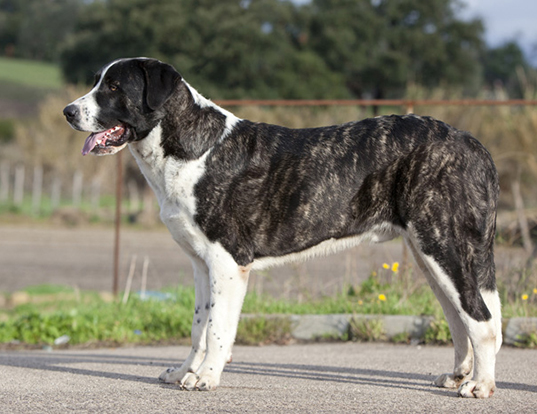
The Rafeiro do Alentejo is a Portuguese breed of livestock guardian dog. It is named for its area of origin, the Alentejo region of southern Portugal. It is recognised by the Clube Português de Canicultura and was definitively accepted by the Fédération Cynologique Internationale in 1954.
The Rafeiro do Alentejo is believed to have originated in the Middle East. Dogs of this type were used to protect flocks during the biannual transhumance from the plateau of Alentejo to the mountains, and then back again. Since the late nineteenth century, they have been known as Rafeiro do Alentejo. In 1954 the breed was accepted by the Fédération Cynologique Internationale in Group 2, Section 2.2: Mastiffs, Mountain Type, Portugal.
The Portuguese breed club is the Associação dos Criadores do Rafeiro do Alentejo. The breed is considered “vulnerable”.
The Rafeiro is a large dog, slightly longer than it is tall, with a broad chest. The head is massive; the eyes are small and dark, the ears small, triangular and hanging. The coat is dense and straight, of short or medium length. It may be black, fawn, wolf grey or yellow, either brindled or not, but always with white markings; or maybe white marked with these colours. It is not as thick as the coat of other pastoral dogs such as the Polish Tatra. Read More…
12. Saint Miguel Cattle Dog
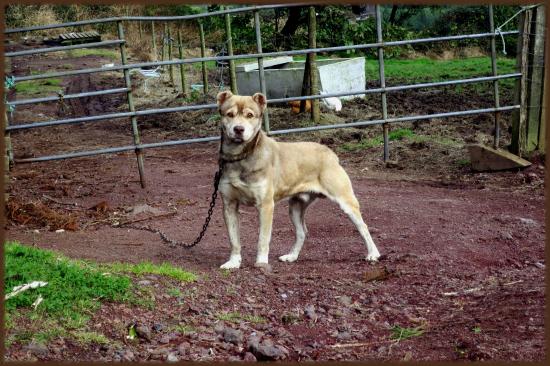
The Saint Miguel Cattle Dog (Portuguese: cão fila de São Miguel [ˈkɐ̃w̃ ˈfilɐ dɨ ˈsɐ̃w̃ miˈɡɛɫ], literally ‘catch dog of São Miguel’) is a dog breed of molosser type originating on São Miguel Island in the Azores, an island chain which is one of the autonomous regions of Portugal. The breed was originally used as a herding dog for working with cattle.
The breed is large but not over-sized; up to a maximum of 60 cm (23.6 ins) at the withers and 35 kg (77 lbs) in weight, with females slightly smaller. The general appearance is of a normally proportioned, deep-chested, muscular dog with a broad head and medium-length neck, straight back, and long legs. The tail is held up and is slightly curved. The breed has drop ears unless they are cropped. The coat is a brindle of brown (pale brown is described as fawn) or grey, with black; it is short, smooth and harsh to the touch, with a short fringe on the tail (if undocked) and on the backs of the rear legs.
The breed is named for São Miguel Island in the Azores, settled by the Portuguese, beginning in 1439. Another of the Azores, Terceira Island, is known for bullfights and cattle raising; large dogs used on cattle there were brought to São Miguel Island and contributed to the development of the breed.
According to the original breed standard, the existence of the cão fila de São Miguel has been documented since the early 19th century. A breed standard was developed in the breed’s area of origin and first published in 1984. This standard was recognised internationally in 1995 when the standard was published by the FCI, with the English name Saint Miguel Cattle Dog. Although described (and formerly used) as a cattle dog, the breed is a molosser, and is thus recognised by the FCI in its “Group 2, Section 2, Molossoid breeds” as breed number 340. Today it is primarily used as a companion dog.
Traditionally, the tail is docked, and the ears cropped and rounded off on top, although these practices are now illegal in many areas. The reasons for these traditions are uncertain but believed to ensure tails and ears cannot be bitten by cattle when herding.
Today, dogs from São Miguel are exported to North America and other areas of the world where they are bred and promoted for the rare breed market. Minor kennel clubs, and registries maintained by individual breeders, write their versions of the breed standard, which may vary from the breed standard developed on the island of São Miguel and recognised internationally by the FCI. Dogs of the breed may be sold under the original breed name, cão de fila de São Miguel, or any of the many translations and versions of the name in various languages. The term Azores cattle dog has been applied by one breeds-index website but does not appear to be a common name for the breed.
13. Terceira Mastiff
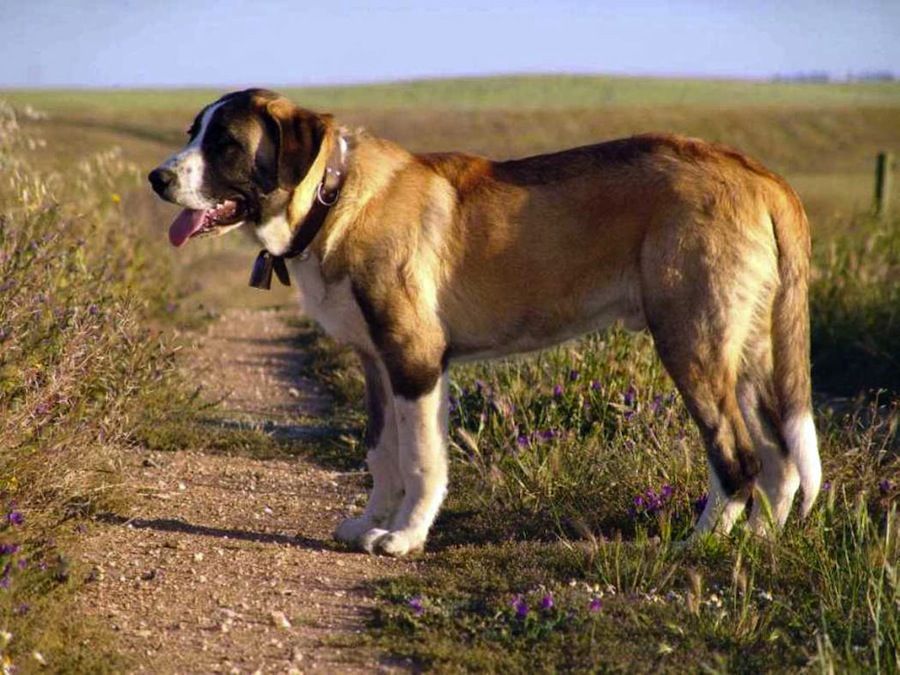
The Terceira Mastiff (Portuguese: [Cão de Fila da Terceira]) is a Portuguese dog landrace, also known as the Rabo Torto Molosser Dogs. Neither the Fédération Cynologique Internationale nor the local Clube Português de Canicultura has officially recognized it. It is an ancestor to both the Cão Fila de São Miguel and the Fila Brasileiro . This breed is fully different from the Barbado da Terceira.
The Terceira Mastiff comes from the island of Terceira, located in the Azores. It descends from local dogs, old Spanish and English mastiffs and bulldogs, the Dogue de Bordeaux and the Bloodhound. According to a legend, it once was very popular among the pirates of the region and soon became a popular fighting dog as well. In the 1880s, veterinarian Dr. Jose Leite Pacheco wrote the first breed standard and intended to make the nickname rabo torto as the official name of the breed instead of the cão de fila da Terceira. The Terceira Mastiff was already extremely endangered that time, which was one of the reasons why – despite the Portuguese standard – it was never accepted by the FCI.
In the 1960s, there was an attempt to revive the breed with the aid of the Portuguese government. However, there was disagreement between government officials and breeders, which led to the project’s failure. After this, the future of the Terceira Mastiff depended solely on local farmers and breed fanciers. In the 1970s, it was already declared extinct, although there were still some individuals left in the Azores. With these few individuals, the recreation of the breed finally began.
The Terceira Mastiff is a medium-sized molosser that represents the Fila or Dogo type and resembles the Cão Fila de São Miguel. One of its most remarkable features is an innately short, corkscrew-like tail. Its nose can be either black, pink or even brown. The colour of the short, smooth coat can be either fawn or yellow, always with a light mask. Red, brindle and black individuals are usually considered to be impure. The height is approximately 55 cm (22 in).
